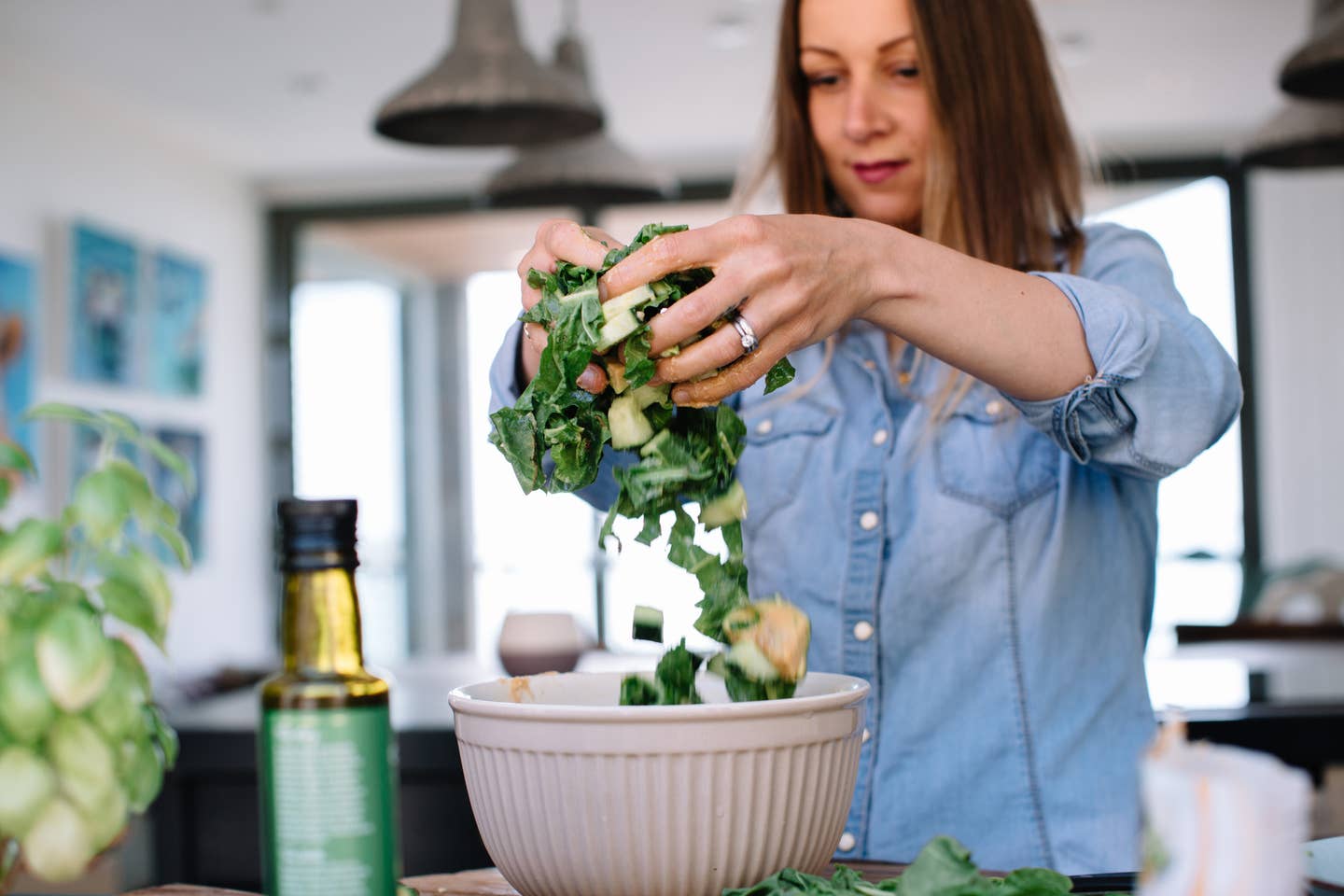
8 Tips to Stay Healthy and Not Gain Weight This Weekend, From RDs
This Memorial Weekend seems all the more special for the fact that we get to gather safely and enjoy ourselves, but along with all that social activity comes the likelihood that indulgent treats, meals, and drinks are everywhere. If one of your goals is to lose weight and get healthier, the weekend may be fraught with potential downfalls. We asked RDs for their best tips to stay healthy and not go off your diet (if you're on one) and still have a great, fun, joy-filled weekend ahead.
The good news: It’s in your hands to have simple strategies that will help you stay healthy at every turn, says Kylie Ivanir, MS, RD so don't despair or think that you are at the whim of your host's menu choices. With these tips from RDs, you can stay healthy under the sun.
1. Treat yourself, without going too crazy.
“Allow yourself to indulge—in moderation! My No. 1 tip for parties where there is a spread of food or a buffet is to first survey all the offerings. I would never recommend going to a party and not eating at least a few things that you really want to,” comments Amy Gorin, MS, RDN, a plant-based registered dietitian and owner of Plant-Based Eats in Stamford, CT. (In fact, if you completely suppress your cravings, you’ll likely cave at some point and overindulge.) “But take a look and decide what’s calling your name the most.
Maybe it’s the cake or cookies, or maybe it’s the candied walnuts or even the French fries or potato chips! Whatever it is, fill up to half your plate with more indulgent offerings—then make it a goal to fill up the rest of your plate with fruits and veggies. No doubt you can find a fruit salad or veggie kebabs!” she adds. Speaking of which these Kate-Middleton-Inspired vegetable skewers are bound to be a big hit.
2. Focus on fiber.
“The first mantra to consider: Fiber First. Fiber is essential when it comes to feeling full and satiated, as it expands in your stomach, decreases hunger hormones, and nourishes your cells. If you’re at a barbecue, add cooked or raw vegetables to your plate, sprinkle nuts and seeds over your salad, or bring some along as a snack,” shares Ivanir. “If you’re attending a potluck, offer to bring along a roasted vegetable side or a bean salad. By starting your meals with fiber, you ensure you are nourishing yourself early on [in the day],” she says. For more on the health benefits of fiber and the best sources of the nutrient, check out our guide.
3. Get enough protein, too.
“In addition to adding fiber to meals, be sure to consume adequate protein in the morning. Starting out your day with around 20 grams of protein can help reduce cravings throughout the day, allowing you to be more mindful with your food choices,” says Ivanir, highlighting the benefits of having a good protein powder on hand to add to a morning smoothie. Need help selecting a plant-based protein powder? We’ve got you covered here.
4. Stay hydrated.
Guzzle some water. “We often mistake hunger for thirst, and you can get dehydrated pretty quickly at an outdoor gathering. Make sure to drink plenty of water or your water-y beverage of choice—whether that’s flavored seltzer or club soda,” says Gorin.
Riffing on that, Lyssie Lakatos, RDN, CDN, CFT & Tammy Lakatos Shames, RDN, CDN, CFT, a.k.a. The Nutrition Twins, authors of The Nutrition Twins’ Veggie Cure and co-founders of NutritionTwins.com share that they’re big fans of starting off the with drinking a 16-ounce water infusion with lemon, ginger, and mint (check out their recipe here.) “Sip it throughout the day to prevent mistaking thirst for hunger and to save your waistline from consuming excess, tempting picnic/BBQ food and drinks,” they say.
Another smart tip? “Drink a glass [of this infused water] between each alcoholic drink to slow the non-stop flow of calorie-loaded cocktails that also shut off your body’s fat burning. The tangy flavor will make it easy to skip the sugary punch bowl,” adding that you’ll maintain the body's proper fluid balance by doing so and guard against water retention— ”and even prevent constipation and the bloat that comes with it.”
5. Load up on pistachios.
“Pistachios are one of the lowest-calorie nuts, and they’re super satisfying, thanks to their 6 grams of plant-based protein and three grams of fiber per serving. Plus, about 90% of the fat found in these pistachios is unsaturated (the ‘good’ kind), for a trio of nutrients that may help keep you fuller longer, so you’re less likely to overdo it at your next meal,” say The Nutrition Twins, adding that plant-based eaters should take note that they’re a complete plant protein and provide all nine essential amino acids. “Pistachios are delicious and feel like a splurge, so you won’t miss fatty snacks that may be calling your name.”
If you buy shelled pistachios, there’s also the added bonus of having to de-shell each one as you eat, which helps slow down how much you eat and also provides you with visual evidence of your munching.
6. Befriend lemons, big time.
The Nutrition Twins are big fans of using lemons as their “weight loss secret weapon.” Noting that they’re nearly calorie-free and replace high-calorie sauces and dressings, as well as salt, “which helps you to feel lighter by preventing bloat and water retention,” you can do a lot with the citrus fruit. “Simply squeeze lemon juice on your salad to replace some, or all, of calorie-dense dressing; squirt it on your grilled veggies, tofu, and tempeh to replace fatty butter, oil, and sauces, and spritz it on potatoes and kebabs to replace sour cream, dressings, and other fatty condiments,” they offer. “You’ll fill up and stay satisfied with the same foods that you love, but you’ll slash hundreds of calories.”
7. Celebrating at a gathering away from home? BYO plant-based recipe.
If you’re gathering with others, make a healthy and filling plant-based dish for everyone to enjoy. “When you’re not sure what’s going to be served, the best way to take control is to bring something healthy and delicious, such as bean salad or a vegan chocolate pudding,” says Gorin. You may have the unintended superpower of winning a friend or family over to plant-based living.
8. Booze better.
“In addition to food, Memorial Day Weekend is often filled with alcoholic beverages. If you will be drinking alcohol, be mindful of what you mix into your drink,” shares Ivanir. “Rather than a sugary cocktail, consider mixing your alcohol of choice with sparkling water and lemon. For a sweeter version, add in a drop or two of monk fruit. This will help prevent a blood sugar spike and crash, which can lead to fatigue and cravings.”
And go ahead and have that bloody mary. That lycopene-packed tomato juice has our seal of approval, and mom’s too.
The Top 20 Veggies with the Most Protein
1. Soy Beans
Soybeans are a legume but they are such a great source of protein that we had to lead the veggie list with it. There is more protein in just one ounce of soybeans than a cup of sliced avocado! 1 cup equals Protein - 28.6g Calories - 298 Carbs - 17.1g Fiber - 10.3g Calcium - 175mg
2. Peas
If the pod, that peas are grown in, is split down the middle, that is an indicator they are ripe. Seeds inside the pod vary and can be green, white or yellow. 1 cup equals Protein - 8.6g Calories - 134 Carbs - 25g Fiber - 8.8g Calcium - 43.2 mg
3. Corn
Fresh corn is a great source of energy for those who like to stay active. Protein isn't all that corn has to offer. Corn provides the body with potassium and B vitamins. 1 cup equals Protein - 5.4g Calories - 177 Carbs - 123g Fiber - 4.6g Calcium - 4.9mg
4. Artichoke Hearts
Artichokes are part of the sunflower family. The fiber in artichoke hearts is great for supporting digestion. 1 cup equals Protein - 4.8g Calories - 89 Carbs - 20g Fiber - 14.4g Calcium - 35.2mg
5. Asparagus
If not properly stored, Asparagus tends to go bad quickly, To elongate freshness, put damp paper towels around the stems, or place the entire asparagus bunch in a cup of water (like flowers) to maintain freshness longer. 1 cup equals Protein - 4.4g Calories - 39.6 Carbs - 7.4g Fiber - 3.6g Calcium - 41.4mg
6. Brussel Sprouts
Brussel sprouts have more Vitamin C than an orange. If your Brussel sprouts have a rancid odor that is an indicator you overcooked them. The smell occurs because the sprouts are composed of a great amount of sulforaphane. 1 cup equals Protein - 4g Calories - 56.2 Carbs - 40g Fiber - 4g Calcium - 56.2mg
7. Broccoli
If you are trying to lose weight broccoli is a great addition to your diet because it consists of 90 water and is also high in fiber. 1 cup (chopped) equals Protein - 3.8g Calories - 54.6Carbs - 11.2g Fiber - 5.2g Calcium - 62.4mg
8. Mustard Greens
Mustard greens provide the body with tons of Vitamin A, Vitamin C, Vitamin K and fiber. Adding steamed mustard greens into your diet has been known to lower cholesterol and reduce inflammation. 1 cup equals Protein - 3.2 g Calories - 21 Carbs - 2.9g Fiber - 2.8g Calcium - 104mg
9. Avocado
Avocado is commonly mistaken as a vegetable but it is technically a fruit. This fruit had to be included in our veggie list because it isn't just tasty but super nutritious. Avocados are packed with protein but they are a great source of potassium and fiber. Avocados are a great addition to any salad, sandwich and even smoothie!
10. Onions
Onions are an unappreciated food hero since they provide 20 percent of your daily Vitamin C and deliver an abundance of antioxidants that can reduce inflammation. 1 cup (chopped) equals Protein - 2.9g Calories - 92.4 Carbs - 21.3g Fiber - 2.9g Calcium - 46.2mg
11. Beets
The entire beetroot is edible including the leaves which contain loads of vitamin A, calcium, iron and potassium. Beetroot is high in sugar but is considered one of the most nutritious veggies used in salads and soups. 1 cup equals Protein - 2.8 g Calories - 74.8 Carbs - 17g Fiber - 3.4g Calcium - 27.2mg
12. Oyster Mushrooms
Oyster mushrooms are commonly seen in Chinese dishes. They grow best in a controlled environment indoors. Oyster mushrooms have so many nutrients to offer besides protein such as iron, calcium, zinc and folic acid. 1 cup (raw and sliced) equals Protein - 2.8g Calories - 37 Carbs - 5.6g Fiber - 2.0g Calcium - 2.6mg
13. Bok Choy
Bok Choy is a member of the mustard family. One of the oldest cultivated vegetables in the world, Bok Choy means "white vegetable” and is a great source of vitamins A, C, B6, K, and E, magnesium, potassium, iron, manganese, and calcium. 1 cup equals Protein - 2.7 g Calories - 20.4 Carbs - 3.1g Fiber - 1.7g Calcium - 158mg
14. Green Beans
Green beans are a great source of vitamins B, C and K, and minerals such as magnesium, iron and manganese. Green beans should be cooked before eating, to destroy lectins. China is the biggest grower of green beans in the world, exporting over 15 million tons a year. 1 cup equals Protein - 1.8 g Calories - 31 Carbs - 7 g Fiber - 2.7 g Calcium - 37 mg
15. Cauliflower
The most nutritious way to consume cauliflower is steamed. Don't get intimidated by orange, purple or green cauliflower. All three types have the same benefits as white cauliflower. 1 cup equals Protein - 2.2g Calories - 28.6 Carbs - 5.4g Fiber - 2.8g Calcium - 19.8mg
16. Turnip
You can eat the entire plant, root and leaves. The turnip root is high in vitamin C and the greens are high in vitamins A, C, E, B6 and K, believed to counter inflammation. Add turnip roots to soup, or mash them. Add them to salads. 1 cup equals Protein - 1.6g Calories - 28.8 Carbs - 6.3g Fiber - 5.0g Calcium - 197mg
17. Alfalfa Sprouts
Alfalfa sprouts might be little but they sure are powerful. Plus they're quick and easy to grow. They are loaded with Vitamin C, Vitamin K, Iron and more. But because they have been known to carry bacteria, make sure to fully cook alfalfa sprouts if you have a fragile immune system or are pregnant. 1 cup equals Protein - 1.3 g Calories - 8 Carbs - 0.7 g Fiber - 0.6 g Calcium - 10.6 mg
18. Tomatoes
Keep your tomatoes fresher for longer by storing them stem down. When exposed to sunlight the Vitamin C in a tomato will diminish. 1 cup equals Protein - 1.3g Calories - 26.8 Carbs - 5.8g Fiber - 1.8g Calcium - 14.9mg
19. Zucchini
Zucchini has an abundance of potassium, even more than a banana! The reason zucchini isn't high in calories is that it is made up of 95% water. 1 cup equals Protein - 1.2g Calories - 28.8 Carbs - 7.1g Fiber - 2.5g Calcium - 23.4 mg
20. Spinach
Spinach is filled with Vitamin A, Vitamin E, Vitamin K, fiber and protein. The best part about spinach is you can sauté it, blend it or eat it raw! Spinach is best grown in rainy and cool weather. 1 cup equals Protein - 0.9g Calories - 6.4 Carbs - 1.0 g Fiber - 0.6g Calcium - 27.7 mg
More From The Beet






